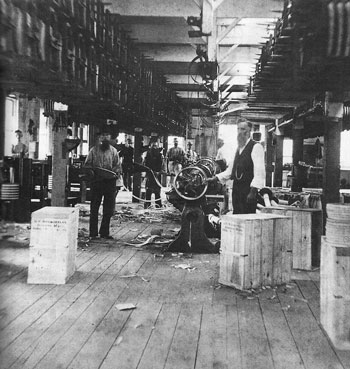B A C K T H E N
Norway Shoe Shop

Photo courtesy of Maine Historic Preservation Commission
Shoe-pegging machines, for attaching outsoles to insoles, in a Norway shoe shop, early ’70s. This factory was built by the town in 1873 to attract a Lynn, Massachusetts, shoemaker. The cases in the foreground are stenciled “B.F. Sturtevant, Boston, Mass.” The first popular automatic shoe-pegging machine was invented by B.F. Sturtevant about 1857. Pegs were made from sapwood of birch or maple. In 1880, about half the shoe shops in the country produced machine-pegged shoes. An 1880 description of the machine explains all:
The characteristic feature of [the process] is a narrow ribbon of white wood, a hundred or more feet long, reeled upon the machine. This ribbon is of the thickness of a peg: its width is just the length of a peg. One edge has, by machinery, been pared sharp; and the grain of the wood runs straight across the ribbon. The operator...has a basketful of shoes brought him, each with the uppers and soles properly adjusted, and tacked to a last. Upon applying them…to the machine, he causes a strong awl…to pierce a series of holes in the leather; simultaneously a sharp knife splits enough wood from the end of the ribbon for a peg; the point of the peg beside it is forced down into place. Both operations take place with the rapidity of a sewing-machine needle, and the shoe has only to be guided and turned while the process goes on.
Perhaps no major industry was more greatly affected by the development of machinery than was shoemaking. Every machine was an attempt to transform a time-consuming, skilled job into a rapid, unskilled operation. Shoe machines that duplicated intricate finger manipulations set new standards for mechanical ingenuity and complexity. From 1836 to the early 1900s, about 7,000 American patents on shoe machinery were granted. By the 1900s, making an ordinary shoe entailed 174 machine operations performed on 154 different machines, along with 36 hand operations. About 300 machines were then involved in the production of footwear.
Aside from the shaping of lasts on a pantographic lathe (modified from a rifle stock machine at the Springfield Armory) and the preparation of the shoe parts, the basic stages of shoemaking were the assembly of the upper materials and the joining of the uppers to the soles. The first successful sewing machine, patented by Elias Howe of Massachusetts in 1846, was adopted for assembling uppers by a Lynn, Massachusetts, shoemaker in 1852.
In 1858, a Massachusetts shoemaker invented a machine that sewed insoles to outsoles, which was purchased by industrialist Gordon McKay. In 1862, a New York mechanic invented a machine, purchased by Charles Goodyear (not the one of rubber fame), that led to the Goodyear welter, which left the insole perfectly smooth. The availability of shoe machinery was of utmost importance during the Civil War, when many shoemakers joined the army just as demand for shoes increased.
The difficult process of “lasting,” or, attaching the upper part of the shoe to the inner sole, whereby the shoe acquired its final shape, long defied automation. No shoe operatives were more active in their opposition to automation than were the highly paid, aristocratic, and hollow-chested—supposedly from pressing against their work—hand lasters. The first successful lasting machine, invented by a Boston lawyer, was developed into the McKay laster in the ’80s. Despite intense efforts at improvement, however, it was suitable only for heavy-grade work. Since most shoemaking involved lighter-grade work, the hand-lasters claimed not to fear it.
The inventor of the first successful mechanical laster for finer footwear was a black immigrant from Dutch Guiana named Jan Matzeliger, a Lynn shoemaker, who applied for a patent in 1882. His machine led to the consolidated lasting machine, and gave birth to the great Massachusetts-based combine, the United Shoe Machinery Corporation. Old lasters claimed that the machine sang as it worked, “I’ve got your job! I’ve got your job!”
E.H.Beals, who recently suicided by shooting, at his home in Everett, Mass., was a former resident of Oxford, this State. Mr. Beals was a mechanical genius…. His latest [invention] was a shoe lasting machine, which was designed to take the place of the McKay laster…fears for the success of his new machine, and the fear of being overreached by several sharpers who were after him, is supposed to have led to his suicide. –The Maine Mining & Industrial Journal, Dec. 7, 1883.
Text by William H. Bunting from A Day’s Work, A Sampler of Historic Maine Photographs, 1860-1920, Part I. Published by Tilbury House Publishers, Gardiner, Maine, 800-582-1899
